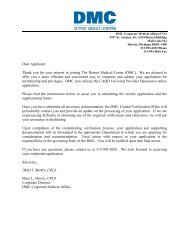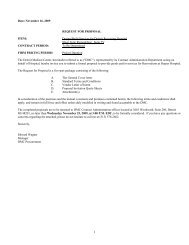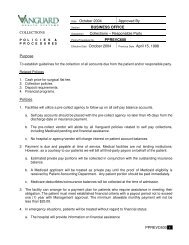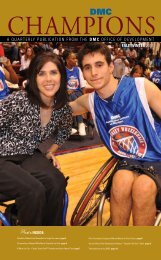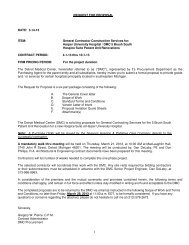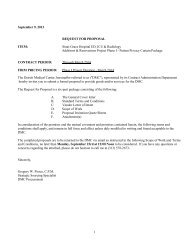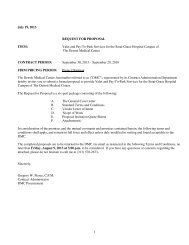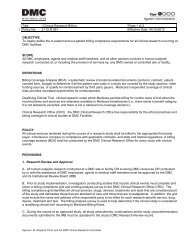Champions - Detroit Medical Center
Champions - Detroit Medical Center
Champions - Detroit Medical Center
You also want an ePaper? Increase the reach of your titles
YUMPU automatically turns print PDFs into web optimized ePapers that Google loves.
CHAMPIONS<br />
A QUARTERLY PUBLICATION FROM THE DMC OFFICE OF DEVELOPMENT<br />
What’s InSIDe:<br />
Celebrity Wheelchair Basketball a Huge Success! page 3<br />
CinemaVision Makes MRIs More Tolerable for Kids page 5<br />
A Race for Life – Cardio Team One Transforms Heart Attack Care page 7<br />
Fall/WInTer 2008<br />
Flinn Foundation Supports Mental Heath at Sinai-Grace page 8<br />
Huron Valley-Sinai Employees Embrace “Together We Can” Spirit page 9<br />
Telemedicine at the DMC page 10
D ear Friends,<br />
The holidays are a perfect time to reflect and give thanks with our families. Even in times of<br />
economic difficulty, great things can be achieved by working together. With this in mind, I would<br />
like to thank our donors, DMC team members and other supporters who have helped pull off some<br />
impressive accomplishments in 2008. I am happy to share a few of them here.<br />
The Leapfrog Group, the health care arm of the nation’s Fortune 500 companies, released its list of<br />
the 33 hospitals in America with the highest standards of safety and quality. The DMC leads the<br />
country. We are the only system in America to place four hospitals on the 2008 list. In fact, we’re the<br />
only system that has ever placed four hospitals on the list. Harper/Hutzel, Children’s, Sinai-Grace<br />
and <strong>Detroit</strong> Receiving Hospitals earned the honor of being named among the 33 finest hospitals in<br />
the country!<br />
Harper’s Cardio Team One is also making significant progress in improving response time and<br />
quality of care for heart attack patients. In just six months, the Cardio Team One approach has<br />
successfully reduced the critically important “Emergency Room door-to-angioplasty balloon”<br />
treatment time from 90 minutes to 45.<br />
These highlights, and others included in this issue, are the result of your hard work, generosity and<br />
commitment. Please enjoy this special season, and take pride in your role in the DMC’s success.<br />
As always, we can not do it without you.<br />
Mike Duggan<br />
President and CEO<br />
<strong>Detroit</strong> <strong>Medical</strong> <strong>Center</strong><br />
On THe COVer:<br />
Cheryl angelelli, rehabilitation Institute of Michigan Marketing<br />
& Pr Director and Jimmy Moceri, Michigan Thunderbirds<br />
Wheelchair Basketball Team<br />
Mike Duggan<br />
President and CeO<br />
<strong>Detroit</strong> <strong>Medical</strong> <strong>Center</strong>
<strong>Detroit</strong> Jams-- radio Personalities (in black) vs. Motor City rollers Sports/news Personalities (blue) (FYI the <strong>Detroit</strong> Jam Won)<br />
Celebrity Wheelchair Basketball a Huge Success!<br />
More than $80,000 Raised for Rehabilitation Institute of<br />
Michigan’s Wheelchair Sports Program<br />
Through the generous support of community sponsors and<br />
local media and sports personalities, DMC Rehabilitation<br />
Institute of Michigan’s (RIM) 7th Annual Celebrity<br />
Wheelchair Basketball Game raised over $80,000 for RIM’s<br />
wheelchair sports program.<br />
The game, held September 23, at U of D Mercy’s Calihan<br />
Hall, featured alumni players from the <strong>Detroit</strong> Lions,<br />
Pistons, Red Wings and Tigers, as well as local TV and radio<br />
personalities, who played in wheelchairs alongside RIM’s<br />
award winning wheelchair basketball team, the <strong>Detroit</strong><br />
Diehards.<br />
“This year’s event has been the most successful to date.<br />
The funds will be used to help Rehabilitation Institute of<br />
Michigan’s wheelchair basketball team travel to local and<br />
national competitions. In addition, proceeds will be used to<br />
provide persons with disabilities the opportunity to participate<br />
in competitive and recreational sports such as skiing, bowling,<br />
and handcycling,” said Myreo Dixon, RIM’s Adaptive Sports<br />
Coordinator.<br />
Ben Carter, DMC Chief Operating Officer<br />
roger McCarville, Disabilities Today and rIM Board Member<br />
“RIM is appreciative of local sponsors such as CareTech<br />
Solutions, Inc., Compuware Corporation, Golden Dental<br />
Plans, and Michigan Regional Imaging, who helped us<br />
surpass last year’s proceeds by nearly $25,000.”<br />
DMC’s Rehabilitation Institute of Michigan is one of the<br />
nation’s largest hospitals specializing in physical medicine and<br />
rehabilitation. RIM is home to many innovative programs,<br />
including the Southeastern Michigan Traumatic Brain<br />
Injury System (SEMTBIS), which conducts groundbreaking<br />
rehabilitation research, and the <strong>Center</strong> for Spinal Cord Injury<br />
Recovery, a world-class facility designed to implement and<br />
study innovative treatments in spinal cord injury recovery.<br />
The DMC is proud to be the Official Healthcare Services<br />
Provider of the <strong>Detroit</strong> Tigers, <strong>Detroit</strong> Red Wings, <strong>Detroit</strong><br />
Pistons and <strong>Detroit</strong> Shock.<br />
TO GIVe<br />
To support Rehabilitation Institute of Michigan,<br />
please visit www.dmc.org/giving.<br />
Peter nielsen of Peter’s Principles<br />
Dr. Jay Meythaler, Professor and Chairman PM&r, WSU & rIM<br />
3
4<br />
Mike Duggan, DMC president and CeO, kicks off the event. Dr. Brooks F. Bock, M.D., F.a.C.e.P., celebrated his retirement at DMC<br />
Guild’s 16th annual Won from the Heart with Cassie Sobelton (far left),<br />
system executive director of business development; Colby Zemmin and<br />
linda O’Brien, Children’s Hospital of Michigan board member.<br />
DMC Guild’s 16th Annual Won from the Heart, held on<br />
August 28th, saw its largest crowd to date, with more than<br />
275 guests. This year’s event benefitted the DMC Heart<br />
Hospital and honored the service of Brooks F. Bock, M.D.,<br />
F.A.C.E.P., who retired in September.<br />
Dr. Bock, within his 35-year tenure, was instrumental in<br />
revolutionizing the field of Emergency Medicine on both the<br />
academic and clinical levels. His accomplishments include<br />
establishing the Department of Emergency Medicine at<br />
Wayne State University School of Medicine; establishing<br />
<strong>Detroit</strong> Receiving Hospital as <strong>Detroit</strong>’s first Level One<br />
Trauma <strong>Center</strong>; developing Trauma <strong>Center</strong>s at several other<br />
1] Kimmy Horne and her band performed a special<br />
r&B rendition of ”rocky Mountain High” in tribute to<br />
Dr. Bock’s plans to retire in Colorado. 2] DMC Guild<br />
presented Dr. Bock with a bench in his honor supporting<br />
the Greening of Brush Mall project. 3] Dr. Samir Fuleihan<br />
and Mrs. Susan Jennings<br />
4<br />
1<br />
DMC hospitals; and masterminding the DMC 29 Minute<br />
Emergency Room Guarantee. Further testaments to his<br />
skill and energy include his position as <strong>Medical</strong> Director of<br />
the <strong>Detroit</strong> Grand Prix since its inception, his selection as<br />
Specialist-in-Chief of Emergency Medicine at the DMC and<br />
his appointment as President of Harper University Hospital<br />
and Hutzel Women’s Hospital. Dr. Bock, along with Dr.<br />
Larry Stephenson, initiated Won from the Heart 16 years ago<br />
as a way to raise awareness and funds that support clinical<br />
programs at the DMC. Dr. Bock will be greatly missed!<br />
TO learn MOre<br />
To learn more about DMC Guild and its<br />
events, visit www.dmc.org/guild/dmcguild<br />
5<br />
2 3<br />
7<br />
6<br />
4] Dr. Seetha Shankaran, director,<br />
neonatal/perinatal medicine,<br />
Dr. Bock and Dr. ”Jack” Baker,<br />
Children’s Hospital of Michigan<br />
board chair 5] Gloria larkins with<br />
Mistress of Ceremonies, Tonita<br />
Cheatham, Harper/Hutzel marketing<br />
and Pr director and Valerie Gibson,<br />
rn, MSa, Cna, vice president<br />
of patient care services 6] Dr.<br />
Suzanne White, Specialist-in-Chief<br />
emergency Medicine and Jenny<br />
atas, M.D. 7] Venicia Foreman and<br />
James P. Young
C inemaVision’s Music, Movies Make MRIs<br />
More Tolerable for Kids<br />
Lying still in a cramped tube for 45 minutes or more is not an<br />
activity most kids classify as “cool.”<br />
But that’s changing at the Children’s Hospital of Michigan,<br />
where patients can now watch their favorite movies or listen to<br />
music during MRI scans. In late June, the hospital installed<br />
a cutting edge CinemaVision Audio-Visual System to help<br />
entertain children during the often-tedious test.<br />
CinemaVision allows young patients to strap on a high-tech<br />
headset with earphones that deliver symphonic digital sound<br />
and “goggles” that produce a high-resolution digital image<br />
similar to watching a 62-inch screen from less than six feet<br />
away.<br />
“It really is cool,” said J. Michael Zerin, M.D., chief of<br />
pediatric imaging. “This was something we’ve wanted for a<br />
long time. It’s been at the top of our list.”<br />
Magnetic Resonance Imaging (MRI) tests combine a large<br />
magnet, radio frequencies and a computer to produce<br />
detailed images of organs and structures within the body.<br />
Unfortunately, MRIs are extremely sensitive to motion and<br />
require patients to remain still throughout the procedure.<br />
That’s especially challenging for children. In fact, more than<br />
70 percent of the 4,000 kids who undergo MRIs at Children’s<br />
each year need sedation before the procedure.<br />
renya alejandro previously was sedated before undergoing an MrI. now, she can<br />
watch “Hannah Montana” and “The Suite life of Zach and Cody” during scans.<br />
By using CinemaVision instead of administering drugs,<br />
Children’s hopes to save time – perhaps as much as two<br />
hours – for patients and their families, eliminate risks that<br />
accompany sedation, and reduce stress and anxiety for kids.<br />
“We can get kids through faster and make them more<br />
comfortable,” Zerin said.<br />
CinemaVision is fully compatible with MRI technology. It<br />
also allows two-way communication between patients and<br />
technicians and doctors, which is a critical safety feature. The<br />
Sinai Guild, a philanthropic organization that supports health<br />
and medical needs in the <strong>Detroit</strong> area, provided funding for<br />
CinemaVision.<br />
“We absolutely understand the fright of the child and the<br />
worrisome part of sedation,” said Rusty Rosman, president of<br />
The Sinai Guild’s 60-member board. “If we can make it easier<br />
for children to have to deal with a medical procedure, we<br />
want to. We’re pleased to make a difference.”<br />
TO GIVe<br />
To support Children’s Hospital of Michigan,<br />
please visit www.dmc.org/giving.<br />
5
6<br />
“I’m very grateful to God, and to Dr. Schreiber and his outstanding<br />
staff at the DMC. I feel like Lazarus in the Bible! Like Lazarus, I was<br />
brought back from the dead – but it wouldn’t have happened if Cardio<br />
Team One hadn’t already been in place and ready to care for me.”<br />
Six months after the launch of Cardio Team One, a<br />
pioneering new treatment approach designed to significantly<br />
lower mortality rates among patients experiencing heart<br />
attacks, the <strong>Detroit</strong> <strong>Medical</strong> <strong>Center</strong> announced it has<br />
successfully reduced the critically important “Emergency<br />
Room door to angioplasty balloon” treatment time for heart<br />
attack patients by half.<br />
The breakthrough finding,<br />
presented at the annual<br />
meeting of the Transcatheter<br />
Cardiovascular Therapeutics<br />
(TCT) Conference in<br />
Washington – the world’s<br />
largest yearly educational<br />
symposium on interventional<br />
cardiology – by DMC<br />
cardiologist Theodore L.<br />
Schreiber, M.D., F.A.C.C.,<br />
was based on a justcompleted,<br />
six-month study<br />
in which the cutting-edge <strong>Detroit</strong> hospital team measured<br />
treatment times for 99 heart attack patients.<br />
The data showed that the DMC approach – in which a<br />
cardiologist and emergency heart attack treatment team are<br />
stationed at the medical facility around the clock – was able<br />
to cut the life-saving treatment time for ER patients with<br />
suspected heart attacks approximately in half, with the average<br />
treatment time of 45 minutes.<br />
This represents a marked improvement over the national<br />
target of 90 minutes, which only 20 percent of hospitals are<br />
—Kay Spencer, heart-attack survivor<br />
N ew Treatment Paradigm Could Transform Heart Attack Care<br />
“For the first time in cardiac care,<br />
we’re asking the doctors to wait for the<br />
patients to arrive – instead of asking the<br />
heart attack patients to wait for us.”<br />
achieving at present. This is the first time ever that such a<br />
reduction in heart attack treatment times has been studied,<br />
and the results are extremely encouraging. They show that<br />
the Cardio Team One approach to heart attack intervention<br />
does significantly reduce treatment times.<br />
Such an improvement in<br />
treatment time could save the<br />
lives of up to seven hospital<br />
patients out of every 100<br />
who would have previously<br />
died, according to the latest<br />
research on heart attack<br />
mortality.<br />
The unique Cardio Team<br />
One “on-site” approach<br />
permits the specialized<br />
DMC unit to rush cardiac<br />
patients immediately into<br />
interventional care, thus<br />
saving the lives of many patients and greatly improving their<br />
quality of life.<br />
“Cardio Team One is an entirely new paradigm in cardiac<br />
care, and it is going to change the way we treat heart attacks<br />
in this country,” said Michael Duggan, president and chief<br />
executive officer of the <strong>Detroit</strong> <strong>Medical</strong> <strong>Center</strong>. “This<br />
approach will also greatly improve the lives of those who do<br />
survive – by preventing the massive injuries to brain tissue and<br />
other vital organs that often take place during a severe heart<br />
attack. Once again, the DMC is setting the standard for heart<br />
care in the United States.”
A Race for Life<br />
The silver Buick LaCrosse pulled up to the<br />
stoplight. It was two o’clock in the morning,<br />
and the driver waited patiently for the light to<br />
turn green. But the woman in the passenger<br />
seat – 60-year-old Kay Spencer, couldn’t<br />
tolerate the delay. “Run the light, Hayden!”<br />
she told her friend behind the wheel. “I don’t<br />
think I can last much longer. Get me to the<br />
hospital as fast as you can!”<br />
As she collapsed into unconsciousness,<br />
Hayden gunned the engine en route to the<br />
Emergency Department at the DMC’s <strong>Detroit</strong><br />
Receiving Hospital.<br />
Kay Spencer’s life hung in the balance and<br />
every second counted. The ailing grandmother was in the<br />
middle of a massive heart attack triggered by a major blockage<br />
in a coronary artery. That artery was almost completely<br />
closed, and her cardiac blood supply had slowed to a trickle.<br />
Within a matter of minutes, the muscle tissue in Spencer’s<br />
laboring heart would begin to die, never to be replaced.<br />
Unless she received lighting-fast treatment – Spencer would<br />
almost certainly die.<br />
It was now a few minutes after two a.m. At most American<br />
hospitals, the nurses and doctors in the ER would examine<br />
the patient carefully, while monitoring her vital signs and<br />
doing their best to stabilize her. She would in due course<br />
receive an electrocardiogram, which would suggest the strong<br />
possibility that she had experienced a heart attack. Only then<br />
would a message go out to the cardiologist – or heart specialist<br />
– who was “on call” at the hospital that night.<br />
In most cases, the cardiologist “on-call” would still be at<br />
home, and probably sound asleep. By the time he or she<br />
dressed and drove to the hospital and then assembled a team<br />
of nurses and technicians to manage the patient’s heart attack,<br />
nearly an hour, on average, would have run off the clock.<br />
That would not be the case tonight, however. Stationed near<br />
the Emergency Room where Kay Spencer had just arrived, the<br />
doctors, nurses and cardiac technicians of the DMC’s Cardio<br />
Team One were waiting to begin treating her heart attack<br />
instantly.<br />
Spencer was about to gain a major benefit from Cardio Team<br />
One’s unique approach to rapidly treating heart attacks. Their<br />
pioneering breakthrough: keeping a highly trained team of<br />
heart attack specialists on duty 24 hours a day, seven days a<br />
week, in order to greatly speed up the treatment process for all<br />
heart attack victims who show up in Emergency.<br />
Cardio Team One was established at the DMC by Theodore<br />
L. Schreiber, M.D., F.A.C.C., a nationally recognized<br />
cardiovascular physician who also serves as its medical<br />
director. Dr. Schreiber’s goal: To cut the typical “medical<br />
response time” to heart attacks to half the current national<br />
average time of between 90 and 120 minutes.<br />
Kay Spencer, with Dr. Schreiber, experienced first-hand the benefits of having<br />
Cardio Team One on-site – not on-call. Fortunately for the retiree, the innovative<br />
cardiac team was in the middle of a regular 48-hour shift – during which all of<br />
the team members live at the hospital, so that they can be dispatched to the er to<br />
begin treating heart attacks within minutes.<br />
When a heart attack strikes, “Time Is Muscle.” The longer<br />
it takes to open up a patient’s clogged arteries and restore<br />
normal blood flow, the more heart muscle will die.<br />
After conferring with the DMC Receiving Emergency<br />
attending physician, Dr. Schreiber quickly concluded that Kay<br />
Spencer was in the middle of a potentially lethal heart attack.<br />
Five minutes later, she was being wheeled into a hospital<br />
Catheterization Laboratory, to undergo a procedure designed<br />
to pinpoint and remove the arterial blockage that had set off<br />
the attack.<br />
During a complex medical procedure that lasted more than<br />
three hours, the pioneering cardiologist and his team were<br />
able to restart the patient’s heart several times after it failed.<br />
“It was touch and go for a while,” said Dr. Schreiber, “but<br />
the team includes some highly capable physicians and nurses,<br />
along with some of the best-trained X-ray technicians in<br />
America.”<br />
When Kay Spencer returned to consciousness, she had no<br />
memory of anything that had transpired that night. “Dr.<br />
Schreiber was the first person to tell me that I’d had a heart<br />
attack,” she said. “And he went on to explain how they’d been<br />
able to keep my heart going and then fix it because they got<br />
started so quickly.”<br />
“I’m very grateful to God, and also to Dr. Schreiber and his<br />
outstanding staff at the DMC. I feel like Lazarus in the Bible!<br />
Like Lazarus, I was brought back from the dead – but it<br />
wouldn’t have happened if Cardio Team One hadn’t already<br />
been in place and ready to care for me.”<br />
TO GIVe<br />
To support Harper University Hospital<br />
and/or <strong>Detroit</strong> Receiving Hospital,<br />
please visit www.dmc.org/giving.<br />
7
F linn Foundation Supports Mental Health Services<br />
at Sinai-Grace Hospital<br />
8<br />
In October 2008, Sinai-Grace Hospital (SGH) was awarded a $450,000, threeyear<br />
grant from the Ethel and James Flinn Foundation. This gift will support a<br />
new integrated care initiative that will provide on-site, integrated mental health<br />
services within the hospital’s Primary Care <strong>Center</strong>. The SGH Primary Care<br />
<strong>Center</strong> served 3,356 patients last year, the majority of whom were uninsured or<br />
underinsured.<br />
Integration of mental health services in the primary care setting is an important<br />
move for SGH and other health care providers. Mental illnesses exacerbate<br />
medical ones, and can be overlooked in a busy clinic setting, where patients’<br />
physical needs take top priority. Referrals from primary care physicians to off-site<br />
mental health facilities are often not followed by patients, who lack the resources<br />
to navigate care options. The goal of the SGH integrated care initiative is to reach<br />
and treat patients with mental illness who would otherwise not seek treatment. Its<br />
objectives are:<br />
• To provide screening to identify patients with depression, anxiety<br />
disorders, phobias, bi-polar illness, trauma/stress related symptoms, or<br />
other mental illness.<br />
• To provide detailed assessment and treatment on-site for identified patients.<br />
• To develop collaborative relationships between medicine and psychiatry to<br />
make patient treatment more comprehensive and accessible.<br />
The Ethel and James Flinn Foundation is a <strong>Detroit</strong> based private foundation that<br />
offers multiple opportunities and resources in support of its mission to improve<br />
the lives of those with mental illness. Established in 1976 by Ethel “Peggy” Flinn<br />
and her brother James H. Flinn Jr., the Foundation is committed to improving<br />
the scope and quality of services for individuals with mental illness. Since its<br />
inception, over $13 million in grants have been awarded.<br />
TO GIVe<br />
To support Sinai-Grace Hospital,<br />
please visit www.dmc.org/giving.<br />
“It’s a great opportunity for us to provide a needed<br />
service in surroundings familiar to the patient.”<br />
—Ellen Portnoy, Administrative Director Patient Services/<br />
SGH Psychiatry and Education<br />
The Ethel and James Flinn<br />
Foundation was established in<br />
1976 by Ethel “Peggy” W. Flinn to<br />
provide a means for coordinating<br />
family philanthropy that would also<br />
serve to honor her parents Ethel G.<br />
and James H. Flinn and her brother<br />
James H. Flinn, Jr., who was<br />
afflicted with schizophrenia in his<br />
early 20’s.<br />
With her brother, James, they<br />
established a philanthropic<br />
organization that would provide<br />
“for the support of research into<br />
the causes and/or research into the<br />
treatment of nervous and mental<br />
diseases.”<br />
For information on Planned Giving<br />
and opportunities for creating your<br />
own philanthropic legacy, contact<br />
DMC Corporate Development at<br />
313.578.2260.
D MC Huron Valley-Sinai Employees Embrace<br />
“Together We Can” Spirit<br />
First-time visitors to DMC Huron Valley-Sinai Hospital’s<br />
(HVSH) campus are usually surprised and impressed at<br />
its lovely setting next to an apple orchard. Broad expanses<br />
of lawn with extensive<br />
landscaping provide a beautiful<br />
environment for patients,<br />
visitors and staff alike. When<br />
the weather is nice, walkers are<br />
often visible. However, there is<br />
no paved path so their choice is<br />
to walk on the grass or on the<br />
road that winds through the<br />
campus.<br />
A number of employees<br />
recognized that the lack of a<br />
designated path was a safety<br />
hazard and that it probably<br />
discouraged potential walkers<br />
from enjoying the campus.<br />
Fortunately, the annual<br />
Employee Giving Campaign presented an opportunity to<br />
improve this situation. Each year, DMC Huron Valley-Sinai,<br />
along with the other DMC hospitals, organizes an Employee<br />
Giving Campaign, led by an employee committee. Each<br />
committee chooses a project that is meaningful to employees.<br />
After soliciting broad employee input, the 2007 HVSH<br />
Employee Giving Campaign committee recommended that<br />
employee contributions be used to build a paved walking<br />
path. “We want employees to feel rewarded at work,” said<br />
Kelly Szmagaj, co-chair of the 2007 and 2008 campaign,<br />
and supervisor of the HVSH Clinical Division, Ambulatory<br />
Services. The hospital’s leadership agreed that a walking path<br />
was a good idea and last year’s campaign raised $25,000<br />
toward construction of the path, about a quarter of its cost.<br />
Since then, the Employee Activity Committee, the Annual<br />
employee Giving Campaign captains meet for the campaign kick-off.<br />
“This project will not only<br />
improve the health and<br />
safety of HVSH employees<br />
but our community as well.”<br />
Golf Committee, the hospital’s Board of Directors and<br />
physicians have contributed to the project. This year’s goal<br />
is 100 percent employee participation to raise the remaining<br />
$25,000 needed for the<br />
project. Campaign co-chairs<br />
Szmagaj and Jeffrey Young, the<br />
hospital’s manager of Security<br />
Operations, have asked that<br />
each employee contribute $1<br />
per pay period to build the<br />
path.<br />
The campaign theme is<br />
“Together We Can” and<br />
it is organized around five<br />
volunteer captains and<br />
multiple departmental<br />
ambassadors, chosen for their<br />
ability to inspire employee<br />
participation, whether through<br />
payroll deduction, a one-time<br />
contribution or donation of vacation days. Fun activities<br />
have been scheduled during the two week campaign rush to<br />
encourage employees to participate. Employees who choose to<br />
walk the perimeter of the campus receive imprinted shoelaces<br />
with the words, “I walk with DMC HVSH. “ Campaign<br />
participants are eligible for dollar lottery tickets, plane rides,<br />
theatre tickets, gift bags and gas card prizes. The campaign<br />
will formally conclude with a shout out ice cream sundae<br />
party in the hospital’s beautiful courtyard. “This campaign<br />
is great fun and the results will greatly benefit employees.<br />
In addition we will serve our patients, visitors and the<br />
community with a walking path,” said co-chair Young.<br />
—Luanne Robak<br />
TO GIVe<br />
To support Huron Valley-Sinai Hospital,<br />
please visit www.dmc.org/giving.<br />
9
Telemedicine at the DMC<br />
10<br />
Telemedicine has many functions. It can be the delivery of<br />
care to a patient from a doctor at a remote location, or the use<br />
of video conferencing to bring doctors “virtually” together for<br />
continuing medical education and patient evaluation.<br />
For example, pediatric cardiologists at DMC Children’s<br />
Hospital of Michigan have been routinely viewing<br />
echocardiograms of patients at community hospitals up to 30<br />
miles away, in real time, since 1998. They currently review<br />
about a hundred cases a month and have saved countless<br />
hours of unproductive time formerly spent driving to those<br />
distant hospitals to review echos.<br />
DMC hospitals have also been involved for nearly two years<br />
in a program that puts monitoring devices into the homes of<br />
elderly patients discharged from DMC hospitals after inpatient<br />
stays. The devices include personal emergency response<br />
systems, monitors for weight, blood pressure, wandering,<br />
respiratory flow, blood oxygen, glucose level, and heart rate,<br />
and an automated medication dispenser that virtually ensures<br />
medication compliance.<br />
Signals from the devices are monitored, so that if something<br />
happens (the patient falls, or their blood sugar shoots up) or<br />
does not happen (the patient does not take meds on time), a<br />
caregiver or medical professional is instantly notified.<br />
The project has multiple goals, including improved quality of<br />
care through constant monitoring, improved quality of life<br />
through reduction of travel for office and hospital visits, and<br />
reduced discharges to nursing homes — which can mean a<br />
better lifestyle for the patient and a lower cost to the health<br />
system as a whole.<br />
All telemedicine activities are geared toward delivering 21st<br />
century care which is defined as the highest quality care at the<br />
lowest possible cost. The two attributes need not be mutually<br />
exclusive, as a telemedicine pilot study at Sinai-Grace Hospital<br />
showed.<br />
The pilot involved placing monitoring devices in the homes<br />
of frail elderly patients after discharge. The majority of these<br />
patients were poor and alone, lacking the financial and family<br />
support resources to follow doctor’s orders. The inevitable<br />
result in such patients is that they soon end up back in the<br />
emergency room for another long hospital stay, having failed<br />
to take their medications, or suffered a fall with no-one<br />
available to help for hours or days. The cost of those incidents<br />
in terms of reduced quality of life for the patient and unreimbursed<br />
hospital expenses is extremely high.<br />
During the six-month pilot study, 39 patients were monitored<br />
at home. Of the monitored patients, the readmission rate was<br />
These are some of the devices worn or used by patients to periodically<br />
transmit vital health data to physicians via the Internet. The system also<br />
alerts physicians and other caregivers if a reading exceeds desired levels.<br />
5%, compared to a readmission rate of 45% for 71 patients<br />
who did not use the monitoring technology.<br />
The pilot study suggested that the program was feasible<br />
to implement, acceptable to urban low income and<br />
minority patients, and beneficial in terms of fewer hospital<br />
readmissions. Considering that a month in the hospital costs<br />
the healthcare system tens of thousands of dollars, a month<br />
in a nursing home costs about $4,000, and a month of home<br />
medical monitoring costs no more than about $150, the<br />
economic savings of telemedicine is substantial. <strong>Detroit</strong>’s<br />
Medicaid agency, the <strong>Detroit</strong> Area Agency on Aging, has<br />
provided some coverage for select patients to remain in the<br />
program, which continues and has even been expanded to<br />
include other DMC adult hospitals.<br />
If you would like to learn more about this program, please<br />
contact David Ellis, DMC corporate director of planning and<br />
future studies, at dellis3@dmc.org.<br />
TO GIVe<br />
To support the DMC, please visit<br />
www.dmc.org/giving
Golden Years Hutzel Hospital Reunion<br />
Past president and CEO of Hutzel Women’s Hospital,<br />
Frank P. Iacobell’s face lights up and his eyes sparkle as<br />
he recalls a story from his time at Hutzel. A period of<br />
time he fondly refers to as the “Golden Years.”<br />
The “Golden Years” of Hutzel Hospital<br />
were from 1970 through 1995. During<br />
this 25-year period, Hutzel Hospital,<br />
under the leadership of Dr. Robert Mack<br />
and Mr. Frank P. Iacobell, evolved from a<br />
community-based general medical-surgical<br />
hospital with a large obstetrics service, to a<br />
nationally known hospital with programs<br />
in women’s health, orthopaedics and<br />
ophthalmology. In addition to the major<br />
programs, there were many other major<br />
medical accomplishments as well.<br />
To celebrate this special period of time, DMC Guild is<br />
hosting a Hutzel Reunion for employees who were there<br />
TO GIVe<br />
To support the DMC Guild, please visit<br />
www.dmc.org/dmcguild<br />
during the “Golden Years” on Saturday,<br />
May 2, 2009, at 6:00 pm at the <strong>Detroit</strong><br />
Athletic Club (DAC). This event will<br />
benefit the renovation of the Charlotte B.<br />
Failing Boardroom.<br />
So mark your calendar! Details are still<br />
being finalized, and more information<br />
will be posted as it becomes available at:<br />
www.dmc.org/dmcguild or you can call<br />
313.578.2215.<br />
Charlotte Failing was a guiding force in the development<br />
of Hutzel Women’s Hospital for more than 50 years.<br />
Elected to the Board of Trustees in 1936, Charlotte served<br />
as recording secretary until 1946, when she assumed the<br />
reigns of president and chairman until 1979.<br />
For 33 years, Charlotte guided Hutzel into becoming<br />
one of the leading hospitals and teaching facilities in<br />
the nation. Under her leadership, Hutzel grew from a<br />
woman’s center to a large general hospital. She was also<br />
a pioneer in the formation of the <strong>Detroit</strong> <strong>Medical</strong> <strong>Center</strong>.<br />
In 1988, Hutzel’s premier boardroom was named in her<br />
honor. The Charlotte Failing Boardroom is still a high<br />
profile meeting area today. Proceeds from the Hutzel<br />
Reunion will benefit the restoration of the boardroom to<br />
its former prominence.<br />
Charlotte Failing passed away February 4, 2004.<br />
In May of 1980 the Hutzel<br />
Hospital auxiliary<br />
commissioned a painting<br />
of Charlotte Failing by<br />
renowned portrait artist<br />
Patricia Burnett. When the<br />
boardroom was named in<br />
her honor in april of 1988<br />
the picture was placed<br />
there and has remained<br />
ever since.<br />
11
To our friends during this holiday season,<br />
Last week, Bob, who lives in Southfield, came to Sinai-Grace Hospital for what he thought<br />
was a bad case of the flu.<br />
Helen, a <strong>Detroit</strong> resident and a diabetic, was brought by ambulance to <strong>Detroit</strong> Receiving<br />
Hospital with a severe infection on her foot.<br />
And ten year old Katie, who lives with her family in Macomb County, was rushed by her<br />
parents to Children’s Hospital of Michigan suffering from an asthma attack.<br />
All of these patients sought help in the Emergency Departments of our <strong>Detroit</strong> <strong>Medical</strong><br />
<strong>Center</strong> (DMC) hospitals.<br />
Bob and Helen have no insurance and Katie’s family doesn’t have enough. Katie’s family has Medicaid,<br />
but it covers only a small portion of the cost of her care. This past year, Bob was let go from his job after<br />
25 years of service. His healthcare ran out three months ago. Helen works two part-time jobs, but neither<br />
offers health insurance. Their total treatment costs were well above average—their illnesses needlessly severe<br />
because of their inability to receive regular care from a primary care physician.<br />
Over 353,000 people were treated in DMC Emergency Departments (ED’s) in the past year. Besides<br />
Sinai-Grace, <strong>Detroit</strong> Receiving and Children’s Hospital of Michigan, we have ED’s at Harper University<br />
Hospital, Hutzel Women’s Hospital and Huron Valley-Sinai Hospital. Many of our patients with more<br />
severe conditions, such as Helen who has diabetes, were admitted to the hospital. Helen was treated at<br />
<strong>Detroit</strong> Receiving Hospital and then transferred to Rehabilitation Institute of Michigan for physical therapy<br />
to regain the function of her leg. In 2007, the DMC spent more than $205 million on care for patients who<br />
are uninsured or underinsured. With a gloomy economic forecast, we expect that number to grow.<br />
Do you know someone who is unemployed or underinsured? Many of us have a friend or relative in this<br />
situation whose only option is an emergency department for primary and acute care. Alarmingly, the<br />
number of emergency departments in the area has dramatically decreased. Twenty years ago, there were 20<br />
emergency departments in the City of <strong>Detroit</strong>. Today there are seven. Five of these are at DMC hospitals.<br />
The DMC is committed to the metropolitan <strong>Detroit</strong> area: all our patients receive the highest quality of care<br />
and are treated with dignity and respect.<br />
Do you know who helps to pay for the care of these patients? Our very special and appreciated donors<br />
who continue to give each year from their hearts to help us fulfill our mission. And do you know who else?<br />
Our employees.<br />
In the past two years, DMC employees have voluntarily contributed $678,769 to help pay for services and<br />
programs for our patients. We greatly appreciate our employees who not only devote their work hours to<br />
the DMC but also give their own dollars to help our patients in need. But DMC employees alone cannot<br />
cover the costs of the uninsured and underinsured who depend on us for care.<br />
The average donation our employees make is $149. Imagine how many more patients could be helped if<br />
you matched our employees’ average donation? Your gift of $149 can cover a lot, like the medical test that<br />
diagnosed Bob’s ulcer; the antibiotics for Helen’s infection, or the medication that will immediately relieve<br />
Katie’s asthma attack. Your $149 will go a long way to help our patients get better.<br />
Our ability to provide care to uninsured and underinsured patients depends in large part on the generosity<br />
of a caring community. This holiday season please consider a donation to one of our DMC Hospitals.<br />
Whatever amount you can contribute will help people like Bob, Helen or Katie who have been hit hard by<br />
this poor economy. And you will have the satisfaction of knowing that you have reached out and<br />
helped your friends and neighbors, just as we do at the DMC.<br />
Wishing you the best of health this Holiday Season.<br />
Sincerely,<br />
Mike Duggan<br />
President and CEO, <strong>Detroit</strong> <strong>Medical</strong> <strong>Center</strong><br />
and the entire DMC family<br />
Office of Development • 3663 Woodward, 5th Floor • <strong>Detroit</strong>, MI 48201<br />
The Specialty Hospitals of the DMC.<br />
1-888-DMC-2500 • www.dmc.org





